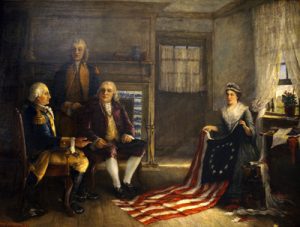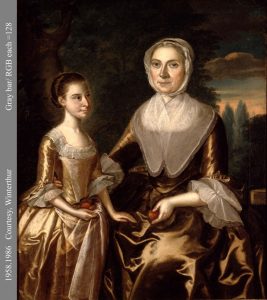 Both readings this week, “Revolutionary Bodies” and “How Betsy Ross Became Famous”, revolve around the lives of white women in the pre Civil War era. Both of these texts emphasize the lack of clarity in the historical record about women in America. Many lower class women did not write at all, and when women did produce written documents they were far less likely to be saved and deemed important. Thus, much of the deductions historians make are based on informal letters, popular linguistic terms at the time, and stories passed on verbally through generations. These methods are of course biased and unreliable as compared to official documentation of events.
Both readings this week, “Revolutionary Bodies” and “How Betsy Ross Became Famous”, revolve around the lives of white women in the pre Civil War era. Both of these texts emphasize the lack of clarity in the historical record about women in America. Many lower class women did not write at all, and when women did produce written documents they were far less likely to be saved and deemed important. Thus, much of the deductions historians make are based on informal letters, popular linguistic terms at the time, and stories passed on verbally through generations. These methods are of course biased and unreliable as compared to official documentation of events.
However, these sources can often provide a look into the social world of these women and how they, as well as men, viewed their role in society. In the Revolutionary Bodies article, Klepp uses linguistic trends to map the attitudes of fertility from 1760-1820. Prior to the 19th century, much emphasis was placed on the belly of pregnant women and the language reflected comparisons between human fertility and the fertility of land and livestock. By the late 18th century, this metaphorical language declined dramatically and along with it the fertility rate. One supposed reason for this is women’s desire to “stress the head and the heart” instead of their bodies. Another plausible correlation is the presence of war causing women to think ahead in terms of economic hardships that come with raising many children.
These reasons depict women as the drivers of their own narrative; however, paintings of women over time also reflect these changes. The portraits shown in the article are all done by men, therefore suggesting that these views also permeated in the minds of men at the time. Paintings also play a role in the Betsy Ross article. Paintings of Betsy Ross presenting the flag to George Washington certainly take control over the narrative and depict Betsy as similar to the Virgin Mary. This mirrors the trends discussed by Klepp about how women were primarily viewed as a source of life. 
Narrative becomes key when discussing the history of colonial women, especially because there is so little documentation to make firm assertions. This problem is at the heart of the Betsy Ross article. There seems to be many conflicting stories in regards to the first flag and who actually made it. What makes Betsy Ross’ story so salient is not its factual accuracy, but it’s appeal to the general public. She has become an icon who is not controversial yet still shows women as strong contributors to the revolution. Ulrich states “her story embodied nineteenth-century ideas about the place of women”. This statement rings true for the changing trends in fertility rates and attitudes as well. As women’s roles shift, so do the art and linguistics surrounding the white female experience. Unfortunately nothing can be extrapolated from these texts to address the trends among lower class women and women of color during this time. It may seem difficult to make deductions about all women during this time period, but uncovering the stories and experiences of women of color is infinitely more difficult.


